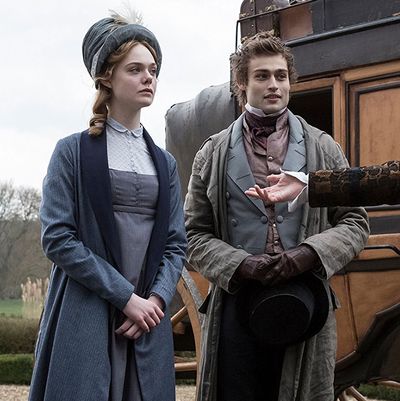
At what point did the artist biopic settle into its current, cemented form? Watching Mary Shelley, the latest unsuccessful attempt to immortalize the teenage girl who created Frankenstein, it boggles the mind that anyone would try to make something mannered from her wild, sad, huge life, and yet that’s what director Haifaa al-Mansour and screenwriter Emma Jensen have given us — a dismal book report that the author herself would have declared fusty. At this point, though, I’m less hung up on Mansour’s disappointing take than with the continued inability of filmmakers to recognize how easily accessible and contemporary the concerns and events of Shelley’s life were, missing every opportunity for immediacy and intimacy in between the biographical lines. It’s a problem with many biopics, but this one, with its surplus of death and sex and enchantment just in the Wikipedia page, feels particularly egregious.
If we’re going to nitpick, the movie should be called Mary Godwin, as nearly all of its events take place before her marriage to the poet Percy Bysshe Shelley. But Mansour’s film’s centerpiece is their scandalous romance, which began when Mary was 15 or 16 and he was 21 and married with children. It’s not a bad centerpiece. After a furtive courtship under her philosopher father’s nose, while Shelley offered his services as an assistant and protégé, the two ran away together, taking Mary’s stepsister Claire Clairmont in tow. The trio faced constant money problems, always on the run from creditors. But their travels eventually brought them into the circle of the star poet Lord Byron, and a fateful summer at his villa in Switzerland where, during a ghost story challenge, Mary was inspired to write Frankenstein, arguably the first modern science-fiction novel.
This is clearly all fantastic material for a film, but the problems begin with the woeful miscasting of Elle Fanning as the title character, and continue from there. Fanning is an able young actress who, as she grows older, increasingly can’t seem to stop posing. She embodies all the listless moroseness required of the original goth girl, but none of the passion; she kisses Shelley (a capably dashing Douglas Booth) like a person who’s desperately afraid to look ugly. Mary had a morbid imagination, but she was not this bloodless blonde Fanning has conjured; she was almost constantly in a state of pregnancy or mourning for her ill-fated infants, the desperate sadness of her most famous novel comes from firsthand experience. The film walks through these events like it’s checking off items from a list, politely omitting sex scenes or the death of her first child, even though the nonverbal dramatic content of those moments should be what fuels our young heroine’s inspiration. (This is also another film that omits the presence of Mary and Percy’s second child, William, among the libertines at Byron’s villa; it’s been incredibly hard for history to square Mary’s status as both a mother of a child and a godmother of science fiction.)
More appropriately cast is Bel Powley as Clairmont, a rambunctious, frequently ridiculous foil for the more reserved Mary. Perhaps because of Powley’s emotive capabilities, her seduction of and abandonment by Lord Byron feels more crucial to Mary’s thematic inspiration; in one of Mansour’s wilder, more impressionistic sequences, she draws that line directly from Dr. Frankenstein spurning his monster to Byron (Tom Sturridge) physically prying Claire off of him in disgust. That relationship, barely articulated in the film at all, feels more raw and relatable than the talky, told-not-shown love between Percy and Mary. But to try to form an almost one-to-one metaphor between these young girls chasing their mercurial poets and Frankenstein’s monster chasing his creator — and to portray Mary’s novel as a declaration of independence from her lover — feels a little misled, and downright confusing when (spoiler alert for history) Mary and Percy reconcile and live together until his death.
If it wasn’t clear already, you’re reading a review of a subpar Mary Shelley biopic by a film critic who has happened to spend a lot of time reading and thinking about the author and her cohort, and I understand my expectations and points of reference might be a little different from the average filmgoer. But I have a hard time believing that someone with even a passing knowledge of Shelley would have the patience for such a literal, literary film. These people are not alive anymore, there’s nobody to perform this kind of staid respectability for. People want to feel a connection to historical figures, not add layers of formalism between us and them. It shouldn’t be this hard, especially when the figure is so electrifyingly out of time as Mary Wollstonecraft Godwin Shelley.




